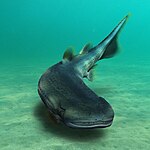
Sarcopterygii — sometimes considered synonymous with Crossopterygii — is a clade of bony fish commonly referred to as lobe-finned fish. They are characterised by prominent muscular limb buds (lobes) within their fins, which are supported by articulated appendicular skeletons. This is in contrast to the other clade of bony fish, the Actinopterygii, which have only skin-covered bony spines supporting the fins.

Eusthenopteron is a genus of prehistoric sarcopterygian fishes known from several species that lived during the Late Devonian period, about 385 million years ago. It has attained an iconic status from its close relationship to tetrapods. Early depictions of animals of this genus show them emerging onto land, but paleontologists now widely agree that eusthenopteron species were strictly aquatic animals.

Panderichthys is a genus of extinct sarcopterygian from the late Devonian period, about 380 Mya. Panderichthys, which was recovered from Frasnian deposits in Latvia, is represented by two species. P. stolbovi is known only from some snout fragments and an incomplete lower jaw. P. rhombolepis is known from several more complete specimens. Although it probably belongs to a sister group of the earliest tetrapods, Panderichthys exhibits a range of features transitional between tristichopterid lobe-fin fishes and early tetrapods. It is named after the German-Baltic paleontologist Christian Heinrich Pander. Possible tetrapod tracks dating back to before the appearance of Panderichthys in the fossil record were reported in 2010, which suggests that Panderichthys is not a direct ancestor of tetrapods, but nonetheless shows the traits that evolved during the fish-tetrapod evolution
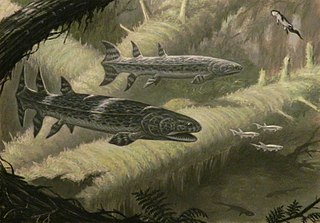
Hyneria is a genus of large prehistoric predatory lobe-finned fish which lived in fresh water during the Famennian stage of the Devonian period.

Tiktaalik is a monospecific genus of extinct sarcopterygian from the Late Devonian Period, about 375 Mya, having many features akin to those of tetrapods. Tiktaalik is estimated to have had a total length of 1.25–2.75 metres (4.1–9.0 ft) based on various specimens.

Holoptychius is an extinct genus of porolepiform lobe-finned fish from the Middle Devonian to Carboniferous (Mississippian) periods. It is known from fossils worldwide. The genus was first described by Louis Agassiz in 1839.
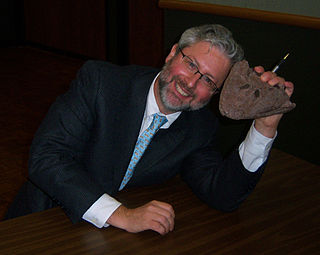
Neil Shubin is an American paleontologist, evolutionary biologist and popular science writer. He is the Robert R. Bensley Professor of Organismal Biology and Anatomy, Associate Dean of Organismal Biology and Anatomy and Professor on the Committee of Evolutionary Biology at the University of Chicago along with being the Provost of the Field Museum of Natural History. He is best known for his co-discovery of Tiktaalik roseae with Ted Daeschler and Farish Jenkins.

Edward B. 'Ted' Daeschler is an American vertebrate paleontologist and Associate Curator and Chair of Vertebrate Biology at the Academy of Natural Sciences in Philadelphia. He is a specialist in fish paleontology, especially in the Late Devonian, and in the development of the first limbed vertebrates. He is the discoverer of the transitional fossil tetrapod Hynerpeton bassetti, and a Devonian fish-like specimen of Sauripterus taylori with fingerlike appendages, and was also part of a team of researchers that discovered the transitional fossil Tiktaalik.

Eusthenodon is an extinct genus of tristichopterid tetrapodomorphs from the Late Devonian period, ranging between 383 and 359 million years ago. They are well known for being a cosmopolitan genus with remains being recovered from East Greenland, Australia, Central Russia, South Africa, Pennsylvania, and Belgium. Compared to the other closely related genera of the Tristichopteridae clade, Eusthenodon was one of the largest lobe-finned fishes and among the most derived tristichopterids alongside its close relatives Cabonnichthys and Mandageria.

Tristichopterus, with a maximum length of sixty centimetres, is the smallest genus in the family of prehistoric lobe-finned fish, Tristichopteridae that was believed to have originated in the north and dispersed throughout the course of the Upper Devonian into Gondwana. Tristichopterus currently has only one named species, first described by Egerton in 1861. The Tristichopterus node is thought to have originated during the Givetian part of the Devonian. Tristichopterus was thought by Egerton to be unique for its time period as a fish with ossified vertebral centers, breaking the persistent notochord rule of most Devonian fish but this was later reinspected and shown to be only partial ossification by Dr. R. H. Traquair. Tristichopterus alatus closely resembles Eusthenopteron and this sparked some debate after its discovery as to whether it was a separate taxon.
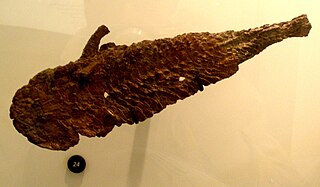
Megalichthyidae is an extinct family of tetrapodomorphs which lived from the Middle–Late Devonian to the Early Permian. They are known primarily from freshwater deposits, mostly in the Northern Hemisphere, but one genus (Cladarosymblema) is known from Australia, and the possible megalichthyid Mahalalepis is from Antarctica.

Laccognathus is an extinct genus of amphibious lobe-finned fish from Europe and North America. They existed from the Middle Devonian to the Late Devonian. The name comes from Greek for 'pitted jaw'.

Langlieria is a genus of prehistoric sarcopterygian, from the end of the Devonian period (Famennian). It was discovered in Belgium and Pennsylvania.

Laccognathus embryi is an extinct species of porolepiform lobe-finned fish recovered from Ellesmere Island, Canada. It existed during the Frasnian age of the Late Devonian epoch.
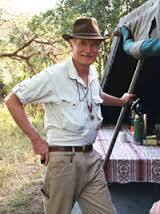
Farish Alston Jenkins was a professor at Harvard University who studied and taught paleontology. His discoveries included a transitional creature with characteristics of both fish and land animals — Tiktaalik roseae —and one of the earliest known frogs, Prosalirus bitis.
The Escuminac Formation is a geologic formation in Quebec. It preserves fossils dating back to the Frasnian, in the Devonian period.
Innovations conventionally associated with terrestrially first appeared in aquatic elpistostegalians such as Panderichthys rhombolepis, Elpistostege watsoni, and Tiktaalik roseae. Phylogenetic analyses distribute the features that developed along the tetrapod stem and display a stepwise process of character acquisition, rather than abrupt. The complete transition occurred over a period of 30 million years beginning with the tetrapodomorph diversification in the Middle Devonian.
Martin Alexander Ernst "Marty" Bergmann was a Canadian scientist and public servant. A marine biologist by training, Bergmann spent 24 years with the Canadian federal Department of Fisheries and Oceans, latterly as Director of the Centre of Expertise for Arctic Aquatic Research Excellence, before taking up the position of head of Natural Resources Canada's Polar Continental Shelf Program. During his career in the Public Service of Canada Bergmann was instrumental in greatly expanding Canada's Arctic research capabilities. He was a leading player in establishing the International Polar Year of 2007–2008, and has been called a "leading and relentless evangelist in national and international scientific circles" by the Royal Canadian Geographical Society (RCGS). He died in the crash of First Air Flight 6560 near Resolute, Nunavut, on 20 August 2011. Since his death numerous memorials have been made to Bergmann, including the naming of the Arctic Research Foundation research vessel Martin Bergmann, the establishment of the RCGS's Martin Bergmann Medal, and the naming of a 375 million year-old fossil fish species found in Nunavut, Holoptychius bergmanni, in recognition of his "scientific endeavors [that] communicated the relevance of the Arctic region to a global audience."
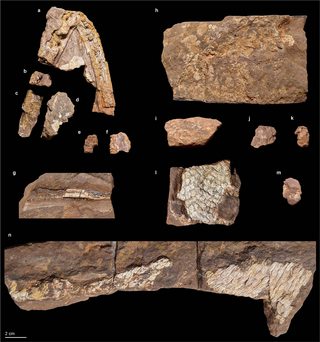
Qikiqtania is an extinct genus of elpistostegalian tetrapodomorph from the Late Devonian Fram Formation of Nunavut, Canada. The genus contains a single species, Q. wakei, known from a partial skeleton. Analysis of the fin bones suggests that Qikiqtania was well-suited to swimming, and likely incapable of walking or supporting itself out of the water, as has been suggested for the closely related Tiktaalik.
The Zachelmie trackways are a series of Middle Devonian-age trace fossils in Poland, purportedly the oldest evidence of terrestrial vertebrates (tetrapods) in the fossil record. These trackways were discovered in the Wojciechowice Formation, an Eifelian-age carbonate unit exposed in the Zachełmie Quarry of the Świętokrzyskie Mountains (Holy Cross Mountains]. The discovery of these tracks has complicated the study of tetrapod evolution. Morphological studies suggest that four-limbed vertebrates are descended from a specialized type of tetrapodomorph fish, the epistostegalians. This hypothesis was supported further by the discovery and 2006 description of Tiktaalik, a well-preserved epistostegalian from the Frasnian of Nunavut. Crucial to this idea is the assumption that tetrapods originated in the Late Devonian, after elpistostegalians appear in the fossil record near the start of the Frasnian. The Zachelmie trackways, however, appear to demonstrate that tetrapods were present prior to the Late Devonian. The implications of this find has led to several different perspectives on the sequence of events involved in tetrapod evolution.




